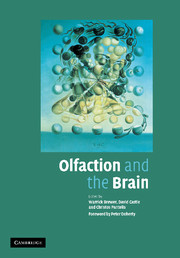Book contents
- Frontmatter
- Contents
- Foreword
- Preface
- List of Contributors
- Section I Neurology, Neurophysiology and Neuropsychology: Olfactory Clues to Brain Development and Disorder
- 1 Structure and Function of the Olfactory System
- 2 Olfaction and the Temporal Lobes
- 3 Role of the Insula in Smell and Disgust
- 4 Olfaction and Memory
- 5 Olfactory Neurogenesis: A Window on Brain Development
- 6 Olfactory Processing and Brain Maturation
- 7 Probes of Behaviour Regulation: Olfactory Models in Addiction
- Section II Social Functioning: Role of Evolution, Genetics and Gender
- Section III Assessment and Disorders of Olfaction
- Index
- Plate section
- References
4 - Olfaction and Memory
from Section I - Neurology, Neurophysiology and Neuropsychology: Olfactory Clues to Brain Development and Disorder
Published online by Cambridge University Press: 17 August 2009
- Frontmatter
- Contents
- Foreword
- Preface
- List of Contributors
- Section I Neurology, Neurophysiology and Neuropsychology: Olfactory Clues to Brain Development and Disorder
- 1 Structure and Function of the Olfactory System
- 2 Olfaction and the Temporal Lobes
- 3 Role of the Insula in Smell and Disgust
- 4 Olfaction and Memory
- 5 Olfactory Neurogenesis: A Window on Brain Development
- 6 Olfactory Processing and Brain Maturation
- 7 Probes of Behaviour Regulation: Olfactory Models in Addiction
- Section II Social Functioning: Role of Evolution, Genetics and Gender
- Section III Assessment and Disorders of Olfaction
- Index
- Plate section
- References
Summary
The scent was so heavenly fine that tears welled into Baldini's eyes. He did not have to test it; he simply stood at the table in front of the mixing bottle and breathed. The perfume was glorious. It was to Amour and Psyche as a symphony is to the scratching of a lonely violin. And it was more. Baldini closed his eyes and watched as the most sublime memories were awakened within him. He saw himself as a young man walking through the evening gardens of Naples; he saw himself lying in the arms of a woman with dark curly hair and saw the silhouette of a bouquet of roses on the windowsill as the night wind passed by; he heard the random song of birds and the distant music from a harbor tavern; he heard whispering at his ear, he heard I-love-you and felt his hair ruffle with bliss, now! Now at this very moment! He forced open his eyes and groaned with pleasure. This perfume was not like any perfume known before. It was not a scent that made things smell better, not some sachet, some toiletry. It was something completely new, capable of creating a whole world, a magical rich world, and in an instant you forgot all the loathsomeness around you and felt so rich, so at ease, so free, so fine …
-from Perfume by Patrick SüskindIntroduction
As Süskind has reminded us in his evocative description of the power of scent, the slightest hint of perfume can transform the present into the past; it can re-create entire sensory experiences by providing an emotional link between past events initially experienced through separate senses; it can make memories seem real and tangible.
Keywords
- Type
- Chapter
- Information
- Olfaction and the Brain , pp. 65 - 82Publisher: Cambridge University PressPrint publication year: 2006
References
- 6
- Cited by

